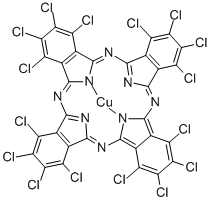Copper(II) phthalocyanine , β-type,> 90.0% , 147-14-8
Synonym(s):
CuPc;Phthalocyanine blue;Pigment Blue 15
CAS NO.:147-14-8
Empirical Formula: C32H16CuN8
Molecular Weight: 576.07
MDL number: MFCD00010719
EINECS: 205-685-1
| Pack Size | Price | Stock | Quantity |
| 25G | RMB77.60 | In Stock |
|
| 100G | RMB208.80 | In Stock |
|
| 500G | RMB650.40 | In Stock |
|
| 2.5kg | RMB2319.20 | In Stock |
|
| others | Enquire |
PRODUCT Properties
| Melting point: | 600°C (dec.) |
| Density | 1.62[at 20℃] |
| storage temp. | Inert atmosphere,Room Temperature |
| solubility | insoluble in H2O, ethanol; soluble in concHSO 4 |
| Colour Index | 74160 |
| form | Fine Crystalline Powder |
| color | Dark blue |
| Odor | odorless |
| Water Solubility | <0.1 g/100 mL at 20 ºC |
| Hydrolytic Sensitivity | 4: no reaction with water under neutral conditions |
| λmax | 602nm(CHCl3)(lit.) |
| Merck | 14,2520 |
| BRN | 4121848 |
| Exposure limits | ACGIH: TWA 1 mg/m3 NIOSH: IDLH 100 mg/m3; TWA 1 mg/m3 |
| InChIKey | XCJYREBRNVKWGJ-UHFFFAOYSA-N |
| LogP | -1 at 23℃ |
| NIST Chemistry Reference | Copper phthalocyanine(147-14-8) |
| EPA Substance Registry System | C.I. Pigment Blue 15 (147-14-8) |
| Absorption | λmax 678 nm (DMF) |
Description and Uses
Copper(II) phthalocyanine, known as CuPc, has been used as an electron donor?with fullerene-C60 or phenyl-C61-butyric acid methyl ester (PCBM) in vacuum-deposited organic photovoltaics (OPV).?Power conversion efficiency of about 1% has been achieved [2] and improved efficiency of 4% with pentacene-doped CuPc layer . CuPc has also been used as a hole-injection material for light-emitting diodes. It has been reported that a thin CuPc layer may effectively enhance the hole injection from the anode to the emissive-polymer layer, resulting in a dramatic decrease of operating voltage of the device . Device stability was achieved by?depositing a copper phthalocyanine CuPc hole-injection layer?HIL on the ITO anode.
Copper(II) phthalocyanine are involved in the study of photosensitizer chemistry for uniform polymerization, luminescence chemistry and spectrophotometric analysis, organic synthesis and polymerization. This pigment is used in enamels, linoleum, inks, plastics, and rubber goods. Photoisomerizable phthalocyanines are used in rewritable CD or DVD printing.Other applications in organic solar cells, biosensitizers and display devices such as OLED , OTFT, Wearable Display, and e-paper.
Safety
| Safety Statements | 22-24/25 |
| WGK Germany | - |
| RTECS | GL8510000 |
| TSCA | Yes |
| HS Code | 32041300 |
| Hazardous Substances Data | 147-14-8(Hazardous Substances Data) |
| Toxicity | LD50 intraperitoneal in rat: > 3gm/kg |






